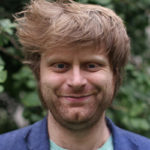High-order Computational Fluid Dynamics
Application to Design of Next-Generation Unmanned Aerial Vehicles
Computational simulation of fluid flow, often referred to as Computational Fluid Dynamics (CFD), plays an critical role in the aerodynamic design of numerous complex systems, including aircraft, F1 racing cars, and wind turbines. CFD technology allows engineers to understand complex flow patterns, and thus perform aerodynamic design, without ever flying an aircraft, or even starting up a wind tunnel. Dr. Peter Vincent, and his team of researchers in the department of Aeronautics at Imperial College London, have been using the Emerald GPU cluster to test the performance of new ‘high-order accurate’ CFD algorithms. Next-generation CFD software based on these advanced algorithms will be able to simulate hitherto intractable flow problems, including those associated with design of next-generation Unmanned Aerial Vehicles (UAVs).
Challenges
Current generation CFD software packages do not meet industrial needs (in terms of accuracy and efficiency). New mathematics – in particular so called ‘high-order accurate’ numerical algorithms – and new software development paradigms – that make effective use of next generation ‘many-core’ computing platforms – are required in order to advance industrial CFD capabilities to a new level of performance.
Solution

Dr. Vincent and his team are developing a new generation of CFD technology that offers increased levels of accuracy at lower computational cost. To do this they are leveraging benefits of (and synergies between) cutting-edge high-order accurate Flux Reconstruction algorithms for unstructured grids, and modern many-core hardware platforms such as GPUs.
If successful, the technology they develop will have a major impact on how CFD is used for industrial design. In particular, their technology would significantly facilitate and improve design of next-generation UAVs, which in the coming decades are set to have a significant impact on our society, playing key roles in areas such as search and rescue, farming, fishing, cargo transport, wireless communications, and weather monitoring There are also various other fields of academic and industrial research where their technology could be transformative, including weather prediction, climate modelling, design of Formula 1 racing cars, and design of quieter passenger aircraft.
The highly cross-disciplinary work of Dr. Vincent and his team involves collaboration between mathematicians, computer scientists, fluid-dynamists and aeronautical engineers in both academia and industry. The work programme is directly supported by a £1.3M EPSRC Early Career Fellowship held by Dr. Vincent (EP/K027379/1), as well as three EPSRC PhD studentships, one Airbus/EPSRC PhD studentship, and hardware donations from Nvidia. The research is also partially supported by a £1.6M EPSRC Platform Grant (EP/L000407/1), and a £0.8M EPSRC UK Turbulence Consortium Grant (EP/L000261/1).
Dr. Vincent and his team rely heavily on access to Emerald, since it allows them to run ‘real-world’ problems of significant size, and test the performance (and in particular the scalability) of their technology on a mid-sized (industry-scale) GPU cluster. Recently they have been using Emerald to undertake high-fidelity transient simulations of flow over a low-pressure T106c turbine blade (test case C3.7 from the recent International Workshop on High-Order CFD Methods, held at DLR, Germany, in May 2013). For industrial relevance, the test case was run at a chord based Reynolds number of 80,000 and an exit Mach number of 0.65 – representative of conditions encountered in the low pressure turbine of a passenger jet during the cruise phase. The pertinent flow feature is a long laminar separation bubble, which leads into a rolling shear layer and the onset of transition (see Fig. 1). Such simulations are invaluable in helping Dr. Vincent and his team demonstrate and refine the capabilities of their cutting-edge CFD technology.
The authors acknowledge the work presented here made use of the Emerald computing facility provided by the Science and Engineering South Consortium in partnership with STFC Rutherford Appleton Laboratory.
Further Reading and References
- Published in Science Direct: PyFR: An open source framework for solving advection-diffusion type problems on streaming architectures using the flux reconstruction approach
Contact

Dr Peter Vincent
Department of Aeronautics, Imperial College London

